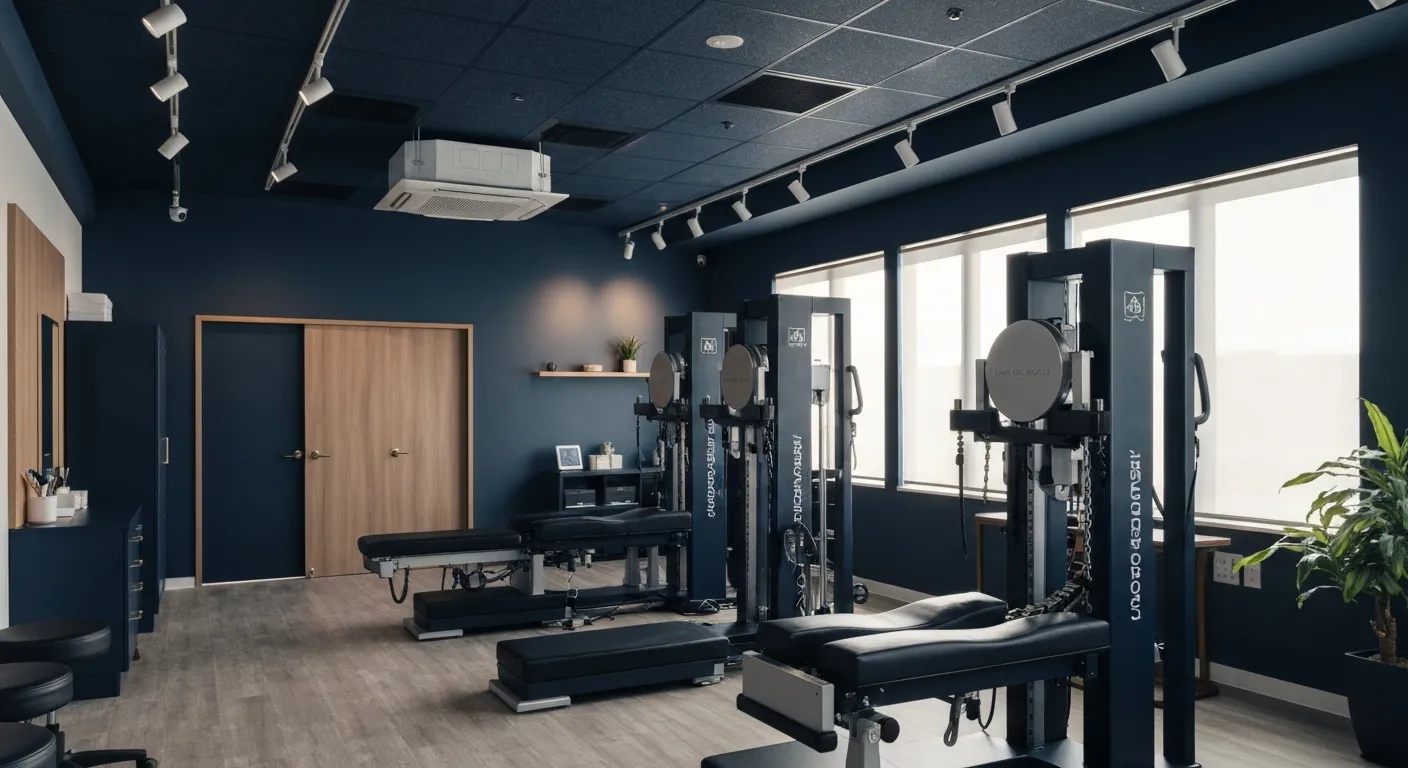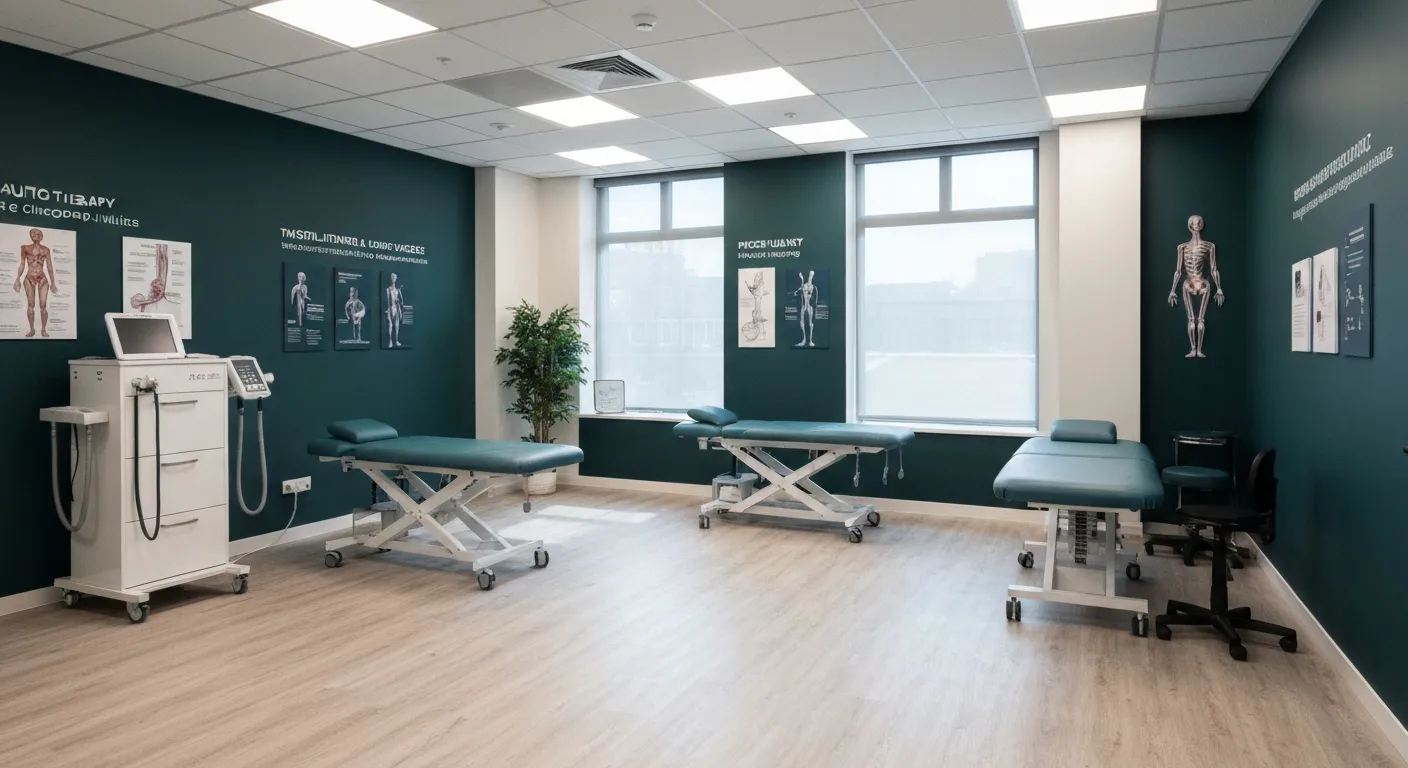Integrating Physiotherapy and Chiropractic: Benefits and What to Expect
October 13, 2025
6 min

A New Path to Comprehensive Musculoskeletal Health
In recent years, healthcare experts have increasingly promoted the integration of physiotherapy and chiropractic care as a superior approach to treating musculoskeletal conditions. This combined strategy harnesses the unique strengths of both physiotherapy and chiropractic adjustments to offer patients faster pain relief, improved mobility, and enhanced overall recovery. By addressing both structural alignments and functional movement, this collaborative care model supports long-term wellness beyond conventional treatments.
Understanding the Roles of Physiotherapy and Chiropractic Care
What are chiropractic care and physiotherapy? How do they differ?
Chiropractic care involves spinal adjustments in chiropractic care and manual manipulations to correct spinal misalignments and subluxations. This helps reduce spine-related pain, improve nerve function, and enhance overall spinal mobility. It often provides instant pain relief by targeting the spine and joints.
Physiotherapy, on the other hand, focuses on restoring and improving movement, strength, flexibility, and muscular balance. It uses exercises and modalities in physiotherapy, manual therapy, and post-surgical rehabilitation techniques directed at muscles, joints, and connective tissues. Physiotherapy aims for long-term functional improvements, injury prevention, and recovery support following injuries or surgeries.
Distinct but complementary treatment techniques
Chiropractic care uses spinal adjustments, joint manipulations, and soft tissue mobilization to restore alignment and decrease nerve irritation. Physiotherapy complements this with targeted exercises, manual therapy (such as joint mobilization techniques and myofascial release), and modalities like ultrasound or dry needling to build strength and enhance flexibility.
Typical conditions addressed by each discipline
Chiropractors commonly treat neck and back pain, headaches, migraines, pinched nerves, and subluxations. Physiotherapists address a broader range including poor posture and shoulder pain, bulging discs, muscular imbalances, post-surgical rehabilitation, and sports injuries. Together, they provide a holistic, personalized spine care approach that addresses both structural alignment and muscular function.
This combined chiropractic and physiotherapy integrated care enhances pain relief, mobility, and endurance while supporting faster recovery and preventing future injuries.
Benefits of Integrating Physiotherapy and Chiropractic Care
What are the benefits of combining chiropractic care benefits and physiotherapy?
Combining chiropractic care and physiotherapy offers a range of advantages that enhance patient outcomes. Chiropractic care involves spinal adjustments to correct misalignments and improve nervous system function, providing quick pain relief and restoring spinal mobility. Physiotherapy complements this by using targeted exercises and manual therapies to strengthen muscles, improve flexibility, and promote endurance.
Enhanced pain relief and mobility
This integrated approach speeds up pain reduction more effectively than either treatment alone. Chiropractic adjustments alleviate nerve compression and muscle stiffness, while physiotherapy addresses muscle imbalances and supports joint function. As a result, patients experience greater mobility and reduced discomfort.
Faster overall recovery and rehabilitation
Combining these therapies accelerates healing from injuries, surgeries, or chronic conditions. The dual focus on spinal alignment and muscle conditioning supports quicker rehabilitation and restores normal movement patterns. This relates to post-surgical rehabilitation techniques and sports injury recovery methods.
Strengthening and injury prevention
Physiotherapy’s specialized exercises enhance strength and flexibility, reducing the risk of future injuries. When paired with chiropractic care, this creates a balanced musculoskeletal system that maintains proper alignment and function over time. These are key elements of strength and flexibility exercises and preventing future injuries.
Holistic and personalized treatment approach
By integrating assessments from both chiropractors and physiotherapists, patients receive tailored treatment plans that address their unique needs. This comprehensive strategy targets not only pain management but long-term wellness, including patient education and ergonomic advice to support ongoing health. It reflects a holistic spine treatment with personalized spine care focus.
Together, chiropractic care and physiotherapy provide a synergistic, drug-free solution that addresses both structural and functional aspects of spine and musculoskeletal health, promoting faster recovery and sustained well-being. This exemplifies the benefits of combining chiropractic care and physiotherapy.
What to Expect During an Integrated Treatment Plan

How does an integrated chiropractic and physiotherapy treatment plan work?
An integrated treatment plan starts with detailed, comprehensive assessments performed by both chiropractors and physiotherapists. These evaluations focus on spinal alignment and muscle function, joint mobility, and overall physical health. Together, they diagnose the root causes of pain or dysfunction with a holistic view.
Initial comprehensive assessments
During the initial phase, both specialists conduct thorough examinations to identify subluxations, muscular imbalances, and movement deficiencies. This comprehensive review aims to capture structural and functional issues impacting the patient's well-being. This joint musculoskeletal assessment by physiotherapists and chiropractors helps ensure accurate diagnosis.
Customized and collaborative treatment plans
Based on assessment results, a personalized and collaborative treatment plan is created. This plan combines chiropractic spinal adjustments to realign the spine and reduce nerve compression with physiotherapy exercises focused on strengthening muscles, improving flexibility, and retraining movement patterns. The collaborative nature ensures each patient's unique needs are addressed effectively with a combined chiropractic and physiotherapy approach.
Typical modalities and techniques used
Treatment often includes manual therapies such as joint mobilization and soft tissue techniques, dry needling, and electrotherapy modalities like TENS or ultrasound, alongside prescribed corrective exercises. These combined approaches target pain relief, enhance mobility, and promote healing for effective sports injury recovery methods.
Patient education and ongoing monitoring
A key component is patient education on posture correction, ergonomic practices, and self-care exercises to support long-term recovery strategies and preventing future injuries. Continuous monitoring allows healthcare providers to adapt the treatment plan based on progress, ensuring optimal outcomes and sustained improvement through personalized spine care.
Target Conditions and Who Can Benefit Most

What conditions benefit most from combined physiotherapy and chiropractic care?
Combining chiropractic care benefits and physiotherapy is highly effective for treating various spine-related issues including treating poor posture and shoulder pain, bulging discs, neck and back pain, headaches, and nerve compression. This integrated approach handles both spinal alignment through chiropractic adjustments for circulation and nerve function and muscular strength and flexibility via strength and flexibility exercises physiotherapy exercises.
It is particularly valuable in post-surgical rehabilitation techniques and sports injury recovery methods, where restoring joint function and rebuilding muscle endurance are critical for quicker and more complete healing.
Patients suffering from chronic pain, recurring injuries, or postural dysfunction benefit from this combined care as it provides long-term recovery strategies while improving overall functional mobility.
The suitability of this dual approach extends across a wide range of patients due to its personalized spine care treatment plans that address unique needs and promote long-term recovery rather than just temporary pain management.
The Holistic Advantage: Collaborative Care and Long-Term Wellness

Why is collaborative care between physiotherapists and chiropractors important?
Collaborative care fosters better treatment outcomes by combining the expertise of physiotherapists and chiropractors. Physiotherapists focus on improving muscle function, endurance, and flexibility, while chiropractors address spinal alignment and nervous system health. By working together with open communication and shared goals, they develop personalized treatment plans that treat both structural and functional aspects of musculoskeletal health.
Emphasis on non-invasive, drug-free treatment
This combined approach prioritizes natural healing methods without relying on surgery or addictive medications. Both physiotherapy and chiropractic care use hands-on, non-invasive techniques such as spinal adjustments, manual therapy, and therapeutic exercises. This strategy reduces pain and promotes recovery safely and effectively.
Role of patient education and prevention
Patient education is a vital component of integrated care. Clinicians teach ergonomic principles, proper posture, and home exercises to empower patients to manage their conditions independently. Prevention strategies aim to detect and correct muscular imbalances and joint dysfunction early, minimizing the risk of re-injury and chronic pain.
Promotion of overall physical resilience and quality of life
By addressing immediate symptoms and underlying causes, the collaborative approach enhances overall physical resilience. Patients benefit from improved mobility, greater strength, and sustained well-being. This holistic model encourages long-term health, supporting everyday function and a better quality of life through ongoing maintenance and self-care.
Towards a Comprehensive Approach to Musculoskeletal Health
Integrating physiotherapy and chiropractic care represents a paradigm shift in musculoskeletal treatment by combining spinal, joint, and muscular expertise into a cohesive, personalized plan. Patients benefit from faster pain relief, improved mobility, and enhanced recovery through this holistic, collaborative approach. With a focus on non-invasive treatments and prevention, this synergy supports lasting wellness, empowering individuals to achieve better physical function and quality of life. As awareness grows, integrating these therapies offers a promising pathway to comprehensive musculoskeletal health.
Recent articles

Sciatica Relief Through Targeted Spinal Decompression

Integrating Physiotherapy with Chiropractic Treatments for Better Results

Testimonials That Demonstrate the Benefits of Chiropractic Care

The Power of Corrective Exercises in Pain Management

A Step-by-Step Guide to Your Initial Chiropractic Consultation

9 Nutritional Tips to Enhance Your Chiropractic Wellness Journey

Patient Experiences: How Chiropractic Care Changed Their Lives

Lifestyle Recommendations to Keep Your Spine in Top Shape

Effective Corrective Exercises for Long-Term Pain Relief

Back Pain Benefits: What Chiropractic Care Can Do for You

Spinal Decompression Techniques for Effective Sciatica Relief

Top Nutritional Counseling Tips for Enhanced Wellness

6 Lifestyle Habits That Boost Spine Health Daily

Discover Holistic and Non-Surgical Pain Relief Solutions

Exploring Holistic and Non-Surgical Treatment Options for Pain

The Role of Physiotherapy in Enhancing Chiropractic Care Outcomes

Complementing Chiropractic Care with Physiotherapy: What You Need to Know

What to Expect During Your First Chiropractic Visit

Simple Lifestyle Adjustments to Maintain a Healthy Spine

Personalized Nutritional Counseling for Improved Health Outcomes

Exploring Non-Surgical Treatments for Spine-Related Conditions

An Introduction to Spinal Decompression for Sciatica Patients

Transformative Success Stories: Patient Experiences with Chiropractic Treatments

Why Chiropractic Care Is Essential for Back Pain Relief

Addressing Underlying Causes Versus Symptom Management in Pain Care

The Role of Nutrition in Enhancing Chiropractic Treatment Effectiveness

Sciatica Treatment Options: Is Spinal Decompression Right for You?

Lifestyle Tips to Maintain a Healthy Spine and Prevent Back Issues

The Synergy Between Physiotherapy and Chiropractic Treatments

What Happens During Your Initial Chiropractic Consultation

Effective Corrective Exercises for Sustainable Pain Management

Taking a Root Cause Approach to Chronic Pain Management

Holistic Pain Management Techniques Without Surgery

How Patient Success Stories Validate Chiropractic Care Benefits

Spinal Decompression: Innovative Treatment for Sciatic Nerve Pain

Spinal Decompression Therapy: A Non-Invasive Approach to Sciatica Relief

Exploring Holistic Approaches Beyond Surgery for Pain Relief

Practical Lifestyle Advice to Support a Healthy Spine Every Day

Corrective Exercise Routines Designed for Long-Term Pain Prevention

Real Patient Stories: Overcoming Chronic Pain with Chiropractic Care

Lifestyle Changes That Promote a Healthy Spine and Prevent Injury

How Addressing the Root Cause of Pain Leads to Lasting Relief

Non-Surgical Holistic Therapies to Manage Chronic Pain Effectively

Nutritional Counseling's Impact on Physical Health and Healing

Benefits of Regular Chiropractic Care for a Stronger Back

Your First Chiropractic Visit: What to Expect and How to Prepare

Patient Experiences: How Chiropractic Care Transformed Their Lives

Exploring Holistic, Non-Surgical Options for Pain Management

Combining Physiotherapy with Chiropractic Treatments for Enhanced Recovery

Holistic Treatments That Offer Alternatives to Surgery for Pain Relief

Corrective Exercise Strategies for Long-Term Spine Health

How Physiotherapy Complements Chiropractic Adjustments for Better Outcomes

First-Time Chiropractic Visitors: What You Should Know

Understanding the Importance of Treating Pain at Its Source

Adopting Lifestyle Changes to Support Your Spine's Wellness

Utilizing Physiotherapy to Enhance Chiropractic Treatment Outcomes

The Key Advantages of Chiropractic Care for Back Pain Sufferers

Why Focusing on Root Causes Improves Pain Treatment Success

Corrective Exercises That Promote Lasting Pain Relief and Mobility

Sciatica Relief Through Targeted Spinal Decompression Techniques

Preparing for Your First Chiropractic Appointment with Confidence

Healthy Lifestyle Habits for Maintaining Spinal Alignment

Success Stories Highlighting Chiropractic's Role in Pain Recovery

Top Benefits of Chiropractic Care for Chronic Back Pain

Nutrition Tips to Boost Your Overall Wellness and Recovery

How Chiropractic Care Alleviates Back Pain Naturally

How Nutritional Counseling Supports Overall Wellness and Spine Health

Step-by-Step Guide to Your First Visit with a Chiropractor

Using Nutrition to Support Chiropractic and Overall Wellness

Integrating Physiotherapy in Your Chiropractic Healing Journey

How Physiotherapy Complements Chiropractic Adjustments for Faster Healing

Lifestyle Tips for Maintaining a Healthy Spine and Preventing Back Pain

Heartwarming Patient Testimonials Highlighting Chiropractic Success

How Proper Nutrition Supports Chiropractic and Physiotherapy Treatments

Combining Physiotherapy and Chiropractic Treatments for Optimal Recovery

Why Chiropractic Treatments Are Effective for Managing Back Pain

Choosing a Chiropractor: Tips for Finding a Trusted Provider

Integrating Physiotherapy and Chiropractic: Benefits and What to Expect

How Tailored Corrective Exercises Can Aid in Pain Management

Chiropractic Care: A Proven Solution for Alleviating Back Pain

What to Expect at Your First Chiropractic Visit: A Comprehensive Guide

The Importance of Root Cause Analysis in Effective Pain Management

The Role of Corrective Exercises in Sustaining Pain-Free Living

Combining Chiropractic and Physiotherapy for Comprehensive Pain Relief

How Addressing Underlying Causes Improves Pain Treatment Effectiveness

Maintaining Spinal Health Through Lifestyle Changes and Preventive Care

Understanding the Benefits of Chiropractic Adjustments for Back Pain Sufferers

Spinal Decompression Therapy: A New Hope for Sciatica Relief

Lifestyle Recommendations to Support a Healthy Spine and Reduce Pain

Choosing the Right Chiropractor: Key Factors to Consider Before Your First Appointment

Non-Invasive Treatment Alternatives: A Holistic Approach to Pain Relief

Corrective Exercises to Support Long-Term Relief from Chronic Pain

Exploring Non-Surgical Approaches to Spine Health and Wellness

Tips for Daily Habits That Keep Your Spine Strong

Success Stories: How Chiropractic Treatments Changed Lives

Why Focusing on the Root Cause of Pain Leads to Better Outcomes

Nutritional Counseling and Its Impact on Overall Wellness and Recovery

Patient Testimonials That Showcase the Power of Chiropractic Care

Preparing for Your First Chiropractic Appointment: What You Need to Know

